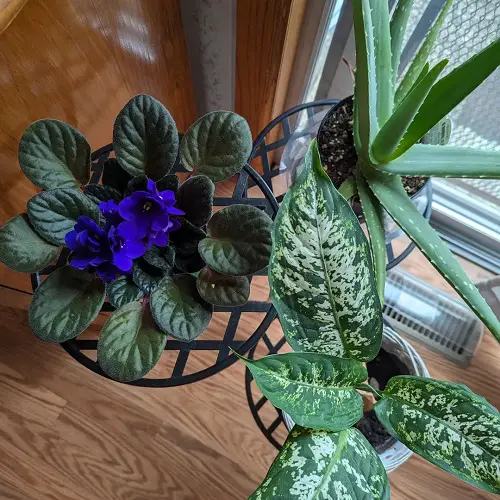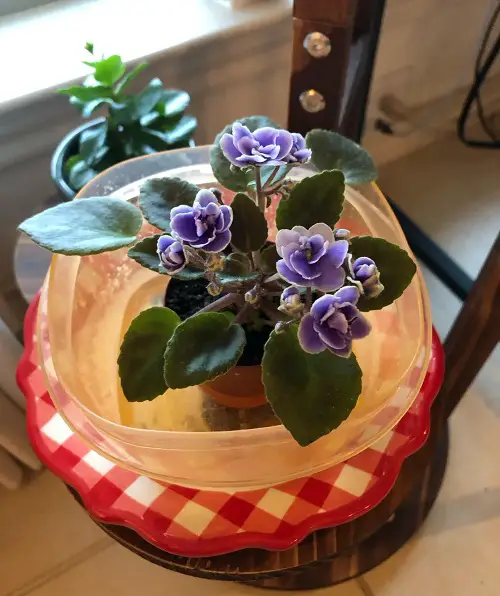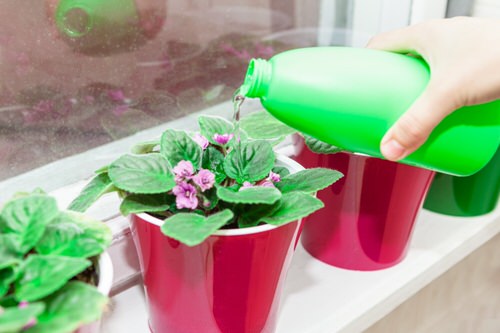It hurts to watch flowers fade and die. That’s why we share 10 Proven Tricks to Force African Violets to Bloom Year Round!
Do African Violets bloom all year round? You can make them! Here are a few tips and tricks to coax your flowers to appear throughout the year, lighting up your home even on the gloomiest days!
Force African Violet to Bloom Year Round
1. Expose it to Bright Filtered Sunlight

Native to the eastern regions of Africa, to mimic its original habitat, this flowering houseplant plant needs ample exposure to “mild” sunlight to bloom and produce a flowering hormone called florigen.
To flower a lot, it needs long, bright days and at least 12-14 hours of indirect or filtered sunlight. While it likes bright daylight, it’s worth noting that the plant doesn’t like seeing the direct scorching sun!
This apt houseplant also flourishes in fluorescent or LED grow lights, which you can use to supplement natural light, especially during shorter days in winter, and provide consistent long hours of light exposure.
2. It’s a Warm Weather Plant

Hardy to USDA zones 10-12, this warm-weather plant can grow in any home; it thrives in 60-80 F (15-27 C) temperature ranges and prefers 60% humidity, if you provide the level around 50-60 percent without fluctuation, they’ll appear best.
If you live in a colder region, you can easily grow it indoors and provide it with the warmth it needs! Keep it in the kitchen or near a fireplace, maintain warm temperatures within your home, and use a humidifier when required.
3. Try Plant Hormones
African Violets can bloom more frequently when treated with plant hormones like cytokinins and gibberellins; this is what the commercial growers do.
Cytokinins can help shoot formation and bud growth. During the active growing season, if you see more leaves than flowers, spray this hormone in a diluted form on the foliage or around the base of the plant, probably mixing one ppm in a liter of water.
Before doing it on all the plants, you can test the results on a small, healthy plant.
Similarly, Gibberellins can help the plant overcome poor growth conditions and stress and help in producing blooms. This is best applied at the beginning of the flowering season. The application method is the same, but the doses differ.
However, overuse can lead to stress and damage to the plant. Use these means sparingly and only if your plant absolutely needs it or shows signs of foliage and stem growth without any blossoms.
4. Use RO Water
African Violets need clean water without chlorine, chloramines, or dissolved solids. Rainwater is a great option, and the next best is water from reverse osmosis.
If using rainwater, make sure the storage container is chemical-free. In some places, tap water works; just keep a jug of water outside for a few hours till the chlorine dissipates.
5. Use Phosphorus-Rich Fertilizer
Once the plant has grown a bit, it needs a phosphorus-rich formula to produce more flowers.
Use fertilizers specifically formulated for African violets, for example, 12-36-14 (N-P-K). For best results, apply the specific fertilizer in half-strength diluted form once every two weeks.
6. Bottom Watering Helps

African violet leaves are sensitive to water and can rot if water sits on them. Watering the plant from the bottom allows roots to absorb moisture directly through its drainage holes. It helps prevent overwatering, as the plant only absorbs what it needs, and its leaves and stems stay nice and dry.
It also strengthens roots, as they constantly grow towards the moisture source, and helps the plant hydrate evenly. Do this only when the soil seems dry, and use lukewarm or room-temperature water to avoid shocking the plant.
7. Keep the Plant Root Bound
African Violets grow better when slightly rootbound. Containing its roots optimizes nutrient uptake, prevents overwatering, and triggers the plant to bloom more. Use a well-draining, light soil mix, perhaps of peat moss, perlite, and vermiculite, and manage its pot size and watering.
Usually, 3 inches pots are suitable for most African violets in the home, but if you notice root-bound symptoms, move the plant to a bigger 4 inches shallow planter, which is usually the maximum recommended size for them!
8. Epsom Salt for Blooms
Epsom salts provide magnesium and sulfur, which may help your African Violet produce more flowers. Magnesium increases chlorophyll production and enhances plant nutrient uptake, improving overall nutrition and replenishing the missing nutrients.
Dissolve 1 teaspoon of Epsom salt in 1 gallon of water and pour it into the soil of your Saintpaulia and other houseplants once a month. Use it more often when you see the plant is deficient in magnesium.
How do you know that? Apart from general poor growth and no flowers, its leaves will turn yellow between its veins. Overuse of Epsom salts can lead to leaf scorch. Read our article on common plant disorders here.
9. Selective Pruning:
Stimulate the plant growth by constantly removing 2-3 older outer leaves every month, but do this only when your plant is actively growing. This will trick the plant into blooming at a faster pace.
So why does this classic trick work? The plant can simply channel more energy and resources into producing flowers rather than maintaining old foliage.
Plus, removing older growth also stimulates cytokinin production in roots, an essential plant hormone that helps in new growth and flowering.
10. Keep the Leaves Dust-Free:
Gently brush off the dust on your plant’s leaves. The more dust on leaves, the lower the productivity. Dust often prevents light from reaching the leaves, interfering with photosynthesis and overall plant growth.
Follow these steps and enjoy constant blooms from your evergreen African violets. Check out 29 African Violets display ideas, and remember, all it needs is your understanding! Don’t forget to share your experience via the comments section below.



